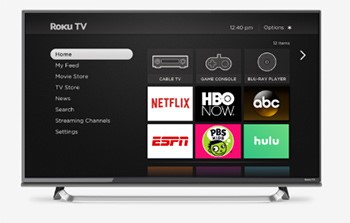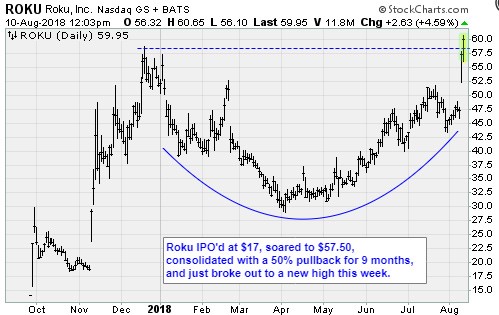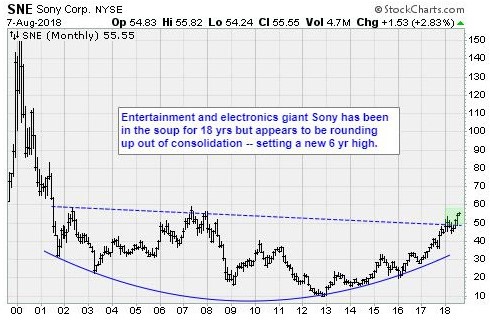Two cord-cutting plays: Roku shares have risen to $57 since the IPO, up 185%, and appear on track for a breakout following a nine-month consolidation. Sony shares trade at only 12.5X trailing earnings. The stock price has gone nowhere since 2007, writes Jon Markman.
Roku Inc. (ROKU), best known for its streaming media hardware, announced August 8 it will bring free movies to the web.
Free is a nice idea. But Roku’s platform is killer.
In many ways, Roku is the little engine that could. Every day, its Linux-based hardware goes up against the biggest and most fearsome technology companies the world has ever known. Every day, Roku wins.
According to Nielsen ratings, in 2016 Roku made up 48% of all streaming players in the United States. At the time, that was good for 14 million active users.
The company reported August 8 that the number of active users reached 22 million at the end of the July, up 46% year-over-year. They streamed 5.5 billion hours of content through the platform.

You can buy a Roku box to stream content, watch it on a Smart TV or, as of this week, visit the Roku Channel on the web.
Like many technology companies, Roku is veering toward monetizing engagement. The idea is to get users hooked on the platform, then find a way to make money from them hanging around. Skeptics say that business model seems a lot like traditional TV. Roku would prefer a comparison to Activision Blizzard (ATVI) or Facebook (FB).
Unlike TV, Roku knows a lot about its active users. That makes them more valuable to marketers.

The Los Gatos, Calif., firm is beginning to prove its mettle. Average revenue per user was up 48%, year over year, to $16.60. More telling, during the second quarter, Roku made more money selling ads, than from hardware. The company reported $90.3 million in platform revenue, up 96%. Hardware sales were $66.5 million, up 24%.
Roku is getting it right. Although it competes on hardware with Amazon.com (AMZN), Alphabet (GOOGL) and Apple (AAPL), its platform is completely open. As a result, apps from all of the major content providers; Netflix (NFLX); Amazon Prime; Google Play; Hulu; HBO Go; and Xfinity, among others play nicely with its platform.
Roku is open, and content providers feel they must be there. Consequently, most of its ad sales come from content partners. In the age of subscriptions, Roku has forged a powerful, and surprisingly effective, business model.
Anthony Wood, Roku’s chief executive officer, says the platform connects the entire TV ecosystem. The ad-supported Roku Channel, available to anyone with an internet connection in the U.S., strengthens that platform.
The company is riding a wave of consumers that are cutting the cord with traditional cable companies. They are choosing the content they want through apps. They get media on demand, and typically at a substantial discount to expensive cable bundles.
Back in September last year, I recommended investors consider buying at Roku at $20 following its IPO. Shares have risen to $57 since then, up 185%, and appear on track for a breakout following a nine-month consolidation.
Sony (sne) is another way to play cord-cutting and the importance of open, streaming media platforms. Once a punchline for corporate incompetence, the Japanese consumer electronics giant is making a comeback with a new business model.
PlayStation Vue, Sony’s media streaming service, offers live TV with local news, sports and access to premium content through apps. Vue also has a personal video recorder service that allows free recording of three shows simultaneously, and playback on any device. The service requires no streaming media box and account holders get five separate user profiles, perfect for a family where viewing interests vary.

In May, the American Customer Satisfaction Index found that video streaming is overwhelmingly preferred over subscription TV packages. PlayStation Vue, with a rating of 78 out of 100, shared the highest index score with Netflix and Twitch, the Amazon.com video game streaming service. The average score of cable TV providers was 62, an 11-year low.
Vue is also part of the larger corporate plan to shift away from hardware to online subscriptions. The Wall Street Journal reported that PlayStation Plus, Sony’s gamer service, had 34 million users as of March, 2018. Converting these users to on-demand entertainment consumers is a logical step.
On a fundamental basis, Sony shares trade at only 12.5X trailing earnings. The market capitalization is still under $70 billion, despite solid 12% sales growth in fiscal 2018. Net income surged 569%.
The stock price has gone nowhere since 2007. A new business model built on the PlayStation platform means a new start and a new reason to consider the shares.
Best wishes,
Jon D. Markman
P.S. I’ll be speaking at the San Francisco Money Show August 24-25. It will be a great show, with all sorts of experts sharing their insights. You can find more about that incredible conference by clicking here. I hope to see you there!
Subscribe to Jon Markman’s Power Elite newsletter here
Subscribe to Jon Markman’s Tech Trend Trader here
Subscribe to Jon Markman’s Strategic Advantage here





















